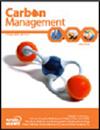Uncovering the effects of policies, climate, and economic development on carbon neutrality in southern Tibet, China
IF 3.2
4区 环境科学与生态学
Q3 ENVIRONMENTAL SCIENCES
引用次数: 0
Abstract
Abstract Partitioning the contributions of climate, economic growth, and policy to a region’s carbon flows is an important process for the Chinese government seeking to optimize their regional development policies to achieve carbon neutrality by 2060. A combination of the carbon emission analysis and human appropriation of net primary production (HANPP) framework was applied to a village in the Lhasa river valley, Tibet, to quantify the contributions of these different factors to carbon flows and neutrality. From 2010 to 2019, the average annual net sequestration of CO2 was 374.9 g CO2 m−2 a−1. Changes in climate conditions and the regional policy of Grassland Ecological Protection Subsidy and Reward increased carbon sequestrations by 409.5 and 25.7 g CO2 m−2 a−1, respectively. Socioeconomic development, policies for reducing poverty, and promotion of forage production led to the increase in CO2 emissions by 103.5, 88.8, and 4.3 g CO2 m−2 a−1, respectively. The cumulative CO2 emissions (including HANPP) caused by land use were 298.92 Tg CO2 (2479.63 g CO2 m−2; 1 Tg = 1012 g), while the cumulative CO2 emissions due to energy use were only 11.22 Tg CO2 (93.07 g CO2 m−2), equal to 3.75% of the CO2 emissions driven by land use. Livestock grazing and cropland cultivation were the two main land use factors affecting the carbon balance. We argue that unhooking economic growth from traditional nomadic animal husbandry and lifestyles through policy optimizations would highly contribute the carbon neutrality in Tibet. Graphical Abstract揭示政策、气候和经济发展对中国藏南碳中和的影响
本文章由计算机程序翻译,如有差异,请以英文原文为准。
求助全文
约1分钟内获得全文
求助全文
来源期刊

Carbon Management
ENVIRONMENTAL SCIENCES-
CiteScore
5.80
自引率
3.20%
发文量
35
期刊介绍:
Carbon Management is a scholarly peer-reviewed forum for insights from the diverse array of disciplines that enhance our understanding of carbon dioxide and other GHG interactions – from biology, ecology, chemistry and engineering to law, policy, economics and sociology.
The core aim of Carbon Management is it to examine the options and mechanisms for mitigating the causes and impacts of climate change, which includes mechanisms for reducing emissions and enhancing the removal of GHGs from the atmosphere, as well as metrics used to measure performance of options and mechanisms resulting from international treaties, domestic policies, local regulations, environmental markets, technologies, industrial efforts and consumer choices.
One key aim of the journal is to catalyse intellectual debate in an inclusive and scientific manner on the practical work of policy implementation related to the long-term effort of managing our global GHG emissions and impacts. Decisions made in the near future will have profound impacts on the global climate and biosphere. Carbon Management delivers research findings in an accessible format to inform decisions in the fields of research, education, management and environmental policy.
 求助内容:
求助内容: 应助结果提醒方式:
应助结果提醒方式:


